Another Owl Tour today. The weather forecast was not ideal and it was spitting with rain on the drive down to the morning’s meeting point, but after a few days of cold winds and fog and with some forecast sunny intervals we were still quietly confident of a good day for owls.
To begin with, we took a drive round looking to see if we could find a Barn Owl still out hunting, but it seemed the dull and slightly damp start to the day had encouraged them to go to roost promptly. No great surprise, as they have not been out hunting much into daylight hours this winter so far – after a mild and dry end to 2016, they have probably entered the New Year in very good condition. We decided to try our luck for Little Owls instead.
The sun was beginning to poke out from behind the clouds, so it seemed a good plan to drive round via some local barns to see if they were out sunning themselves. Some of our Little Owls are more sensitive to the weather than others, and it was perhaps still a little cold in the breeze. There was no sign of any owls around the first couple of sets of barns we stopped at. A Grey Wagtail feeding around a ford was a nice bonus on our travels. It was completely unfazed by the car and was too close to get a good look at, so we had to manoeuvre back!
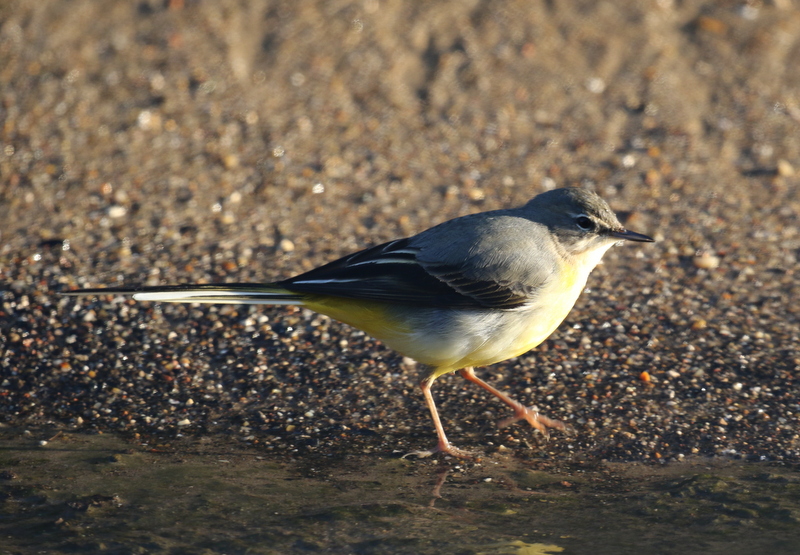 Grey Wagtail – feeding around a ford right next to the car
Grey Wagtail – feeding around a ford right next to the car
There is one site where the Little Owls are normally more reliable, so we decided to head round there next. Very unusually, there was no sign of any here either today, despite the weather seemingly being not as bad as it often is when we see them here. We waited a while to see if we one might come out and enjoy the rays of sun coming through the cloud, but it was not to be today. Very frustrating!
There were other things here to look at. A couple of Stock Doves perched up on a barn roof. Two Brown Hares were hunkered down in a winter wheat field, looking just like two large clods of earth. A flock of Lapwing and Curlew was feeding in a stubble field, surprisingly tricky to see until they flew round periodically. Flocks of Brent Geese made their way backwards and forwards between the coast and the fields inland where they were feeding.
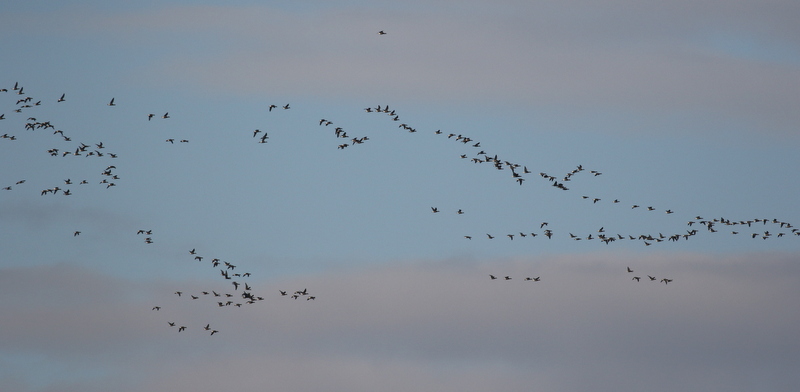 Brent Geese – flying inland to feed on the fields
Brent Geese – flying inland to feed on the fields
With the clouds rolling in again, it seemed best to move on and try something different, so we headed down to the coast and along to Cley. The fields down by the Beach Road were quiet today, but a quick drive down there gave us a chance to see the impact of the recent storm surge, with the car park now much reduced in size having been filled with shingle. The old beach shelter has also been largely filled with stones again! As we drove back round, we could see the debris marking the high tide line, which appeared to have peaked just below the houses along the front.
The East Bank has been a very productive spot in recent days. The storm surge lifted a load of reed litter out of the bottom of the reedbeds and dumped large quantities of it along below the bank. Several birds have been feeding on seeds and insects in the rotting vegetation. A short distance along the bank we came across a huddle of birders staring down at the ditch below. A Siberian Chiffchaff was flitting around on all the reed debris covering the water.
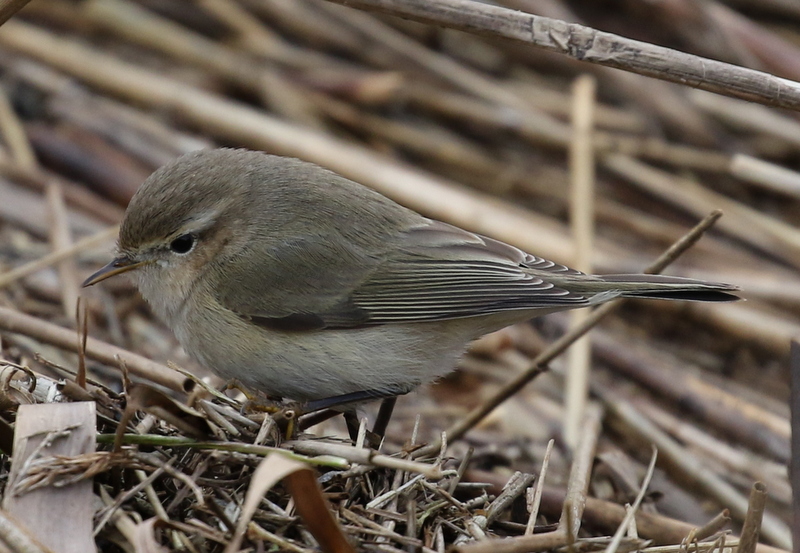 Siberian Chiffchaff – paler than the normal Chiffchaffs, but not heard to call today
Siberian Chiffchaff – paler than the normal Chiffchaffs, but not heard to call today
Siberian Chiffchaff is the eastern counterpart to our Common Chiffchaff. It is paler, more buff/brown and comparatively lacking in green tones to its plumage. Thankfully there were a couple of Common Chiffchaffs around for comparison, much darker and more olive-toned. There is believed to be considerable intergradation between Siberian and Common Chiffchaff in the Urals. The key identification feature for Siberian Chiffchaff is the call, but this bird was silent today. Apparently, others have heard it call and confirm that it is indeed a Siberian Chiffchaff. It is likely that Common Chiffchaffs regularly spend the winter in the reedbeds along the coast, but they are not often seen unless they are flooded out, as they have been hear recently.
The group were keen to see Bearded Tits today (even promising to forgive the lack of owls this morning, if we could find some!). A cold and windy winter’s day would not normally seem to be the best conditions for finding them, but they too have been coming out onto the reed debris along the East Bank. We could hear a few calling as we walked on down the bank, but at first all we saw were two Bearded Tits flying up out of the reeds and disappearing off away from us.
When we heard another Bearded Tit call close to the bank, we set off to find it. We were treated to cracking views of a smart male coming down to drink. It dropped down out of the reeds on the other side of the ditch and climbed down the short reed stems on the edge of the water. We had a great view of its powder blue head and black moustache.
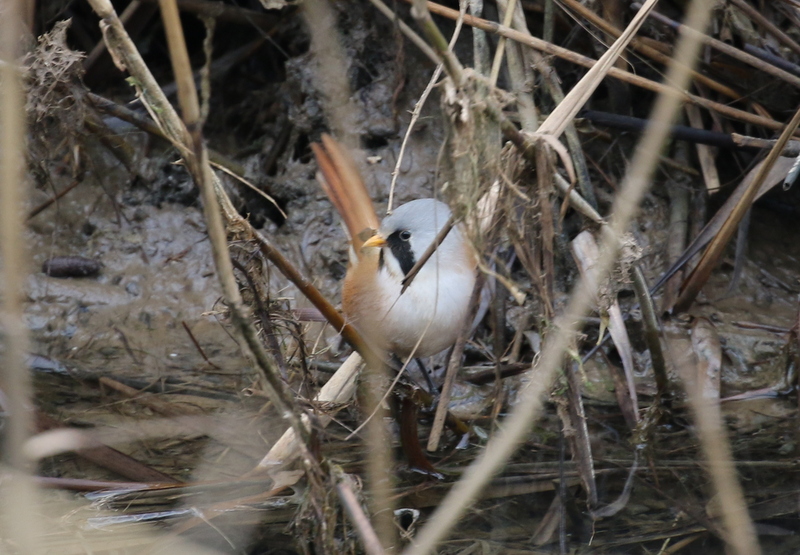 Bearded Tit – coming down to drink
Bearded Tit – coming down to drink
Pope’s Marsh and the flooded meadows around the Serpentine are also one of the best spots for birds on the reserve at the moment. There was a great selection of ducks out here today. There were several Pintail, and we got a smart drake in the scope, admiring its long pin-shaped tail as it upended in the shallow water. There were also little groups of Teal and Shoveler sleeping round the water’s edge. Further over, a flock of Wigeon were grazing on the edge of Pope’s pool – we could hear them whistling. A bright female Shelduck was feeding down at the front.
There has been a female Smew around the reserve for almost three weeks now, but it is often elusive. Presumably, it spends a lot of time feeding in the ditches where it cannot be seen. Today we were lucky. As we were scanning through the ducks around the Serpentine, we found it in with some Teal. At first, it was swimming around, but then it walked up onto a strip of mud and went to sleep. We could still see its white cheeks and rusty cap. Smew is an arctic breeding species. Birds disperse south for the winter, but the numbers reaching the UK seem to have dropped considerably in recent years, possibly due to milder winters on the continent. So this is a great bird to see.
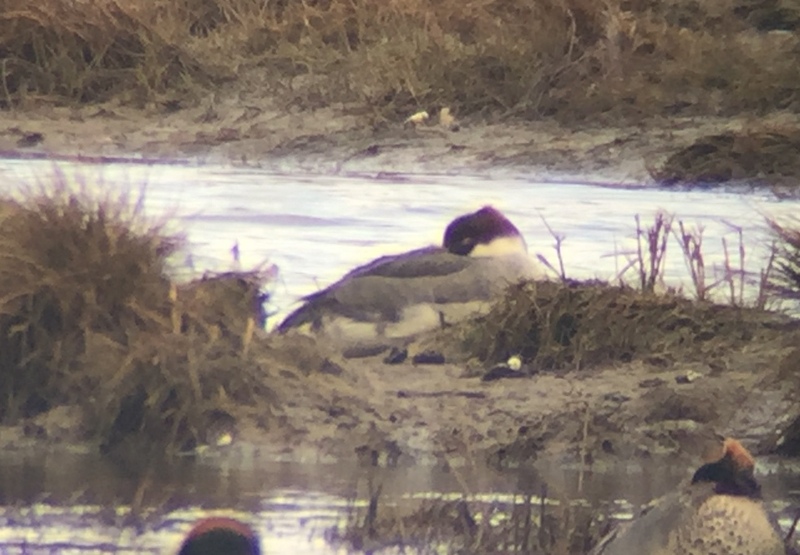 Smew – the female still hanging around the Serpentine with Teal today
Smew – the female still hanging around the Serpentine with Teal today
It has been a good January for Glaucous Gulls here and it wouldn’t be a day out on the coast (or sometimes inland too!) without seeing one this year. A juvenile Glaucous Gull was out on one of the islands on Pope’s Marsh. Through the scope, we could see its pale wing tips and pink-based, dark-tipped bill. It wasn’t doing much and it didn’t look especially well, so perhaps it was no surprise that it was unfortunately found dead the following day.
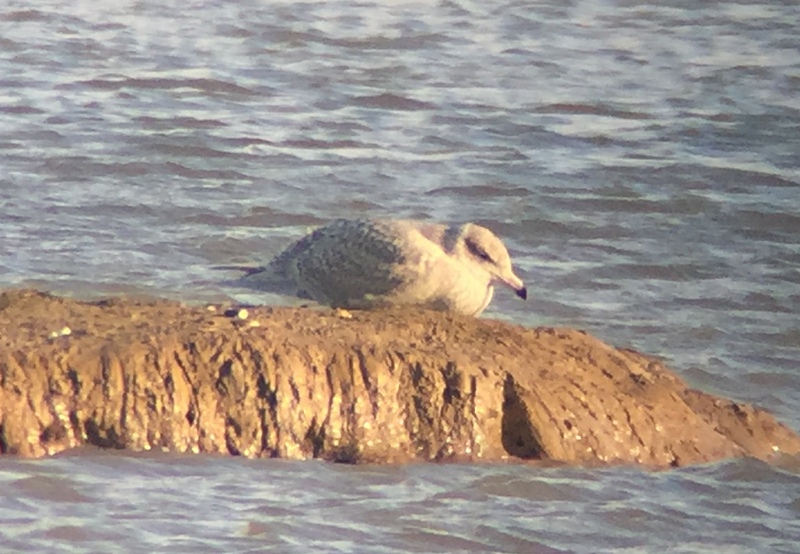 Glaucous Gull – this sickly juvenile was out on Pope’s Marsh
Glaucous Gull – this sickly juvenile was out on Pope’s Marsh
Four Marsh Harriers circled up out of the reedbed and one was chased off by the resident female and flew over our heads and off towards Pope’s Marsh.
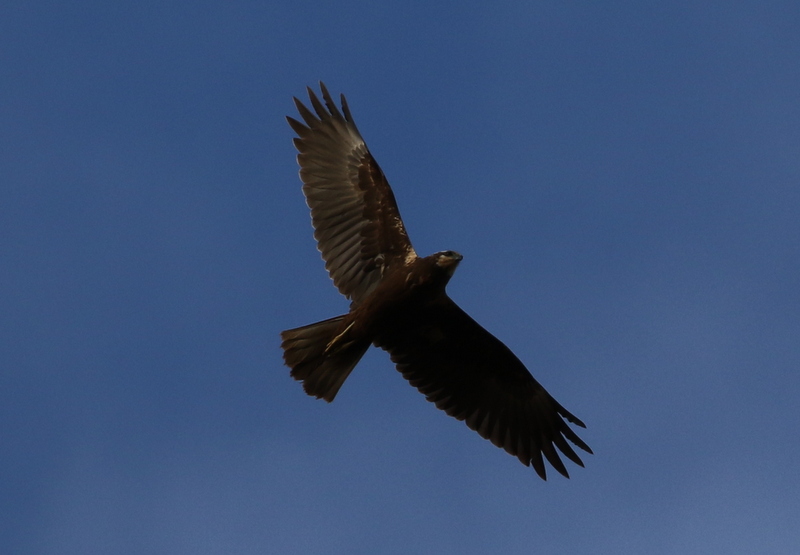 Marsh Harrier – one of four, this one circled over our heads
Marsh Harrier – one of four, this one circled over our heads
It wouldn’t be a visit to the East Bank without a look at the sea, so we carried on out in that direction. We made a quick stop in the shelter overlooking Arnold’s Marsh. There were good numbers of Dunlin and Redshank on here and, over the back, a large flock of Gadwall. Most of the remaining sections of the old shingle ridge have now been flattened, but a small portion remains just east of the East Bank, so we took shelter from the breeze behind that.
There were a few Red-throated Divers and Guillemots out on the sea, but they were hard to get everyone onto as they were diving constantly. A single Great Crested Grebe was a bit more obliging. A couple of adult Gannets flew past. Then we decided to make our way back for lunch.
More Bearded Tits were requested, and it would have been a shame not to deliver! A male was drinking briefly again, in the same spot we had seen one earlier. Another pair came down to the water’s edge a little further along, but also didn’t linger long. But a female Bearded Tit which came down to bathe was so obliging, we got good views of it through the scope, as it kept climbing down to the water and back up the reed stems to preen.
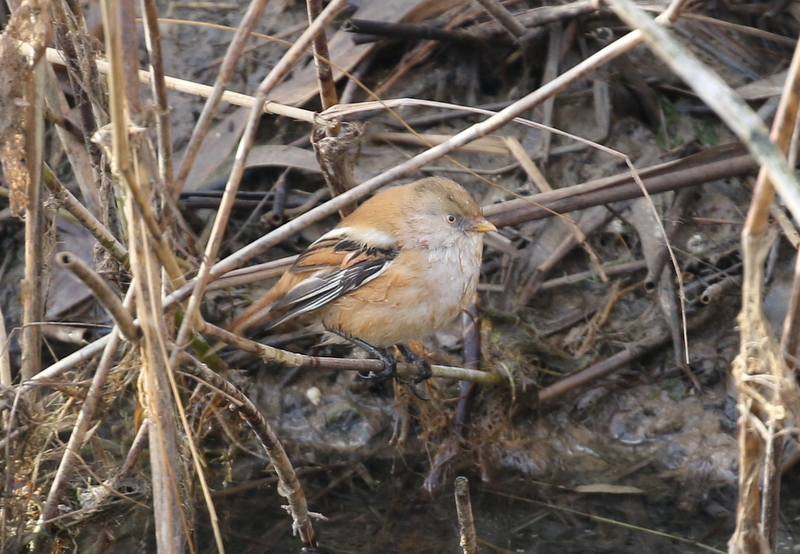 Bearded Tit – this rather damp female came down to bathe
Bearded Tit – this rather damp female came down to bathe
As we walked back towards the car park, we spotted three geese flying towards us from the east. As they approached, we could see they were White-fronted Geese – we could see their white bill-surrounds and the black belly patches on two of them. Presumably a family party, the two adults were flanking a grey-bellied juvenile.
 White-fronted Geese – this family of three flew west overhead
White-fronted Geese – this family of three flew west overhead
After a break for lunch back at the visitor centre, we made our way east along the coast road to Weybourne. There has been a large flock of several thousand Pink-footed Geese feeding in a harvested sugar-beet field here for a couple of weeks now. As we pulled up, we could immediately see the geese. There appeared to be slightly fewer in here today, but that was perhaps because the geese were scattered over a wider area, with several groups loafing in neighbouring fields. There were some nice close Pink-footed Geese which seemed completely unfazed by our presence, giving us a great view of their pink legs and bill bands.
There have been several Tundra Bean Geese with this group and it didn’t take us long to find one. Their day-glo orange legs can really stand out and although it was asleep, one with the closest group of Pinkfeet was easily picked out. The Tundra Bean Goose woke up and then started feeding, giving us a great view of its bill too – mostly dark like the Pink-footed Geese, but with a bright orange rather than pink bank around it. A quick scan of the rest of the field revealed at least another six Tundra Bean Geese much further over.
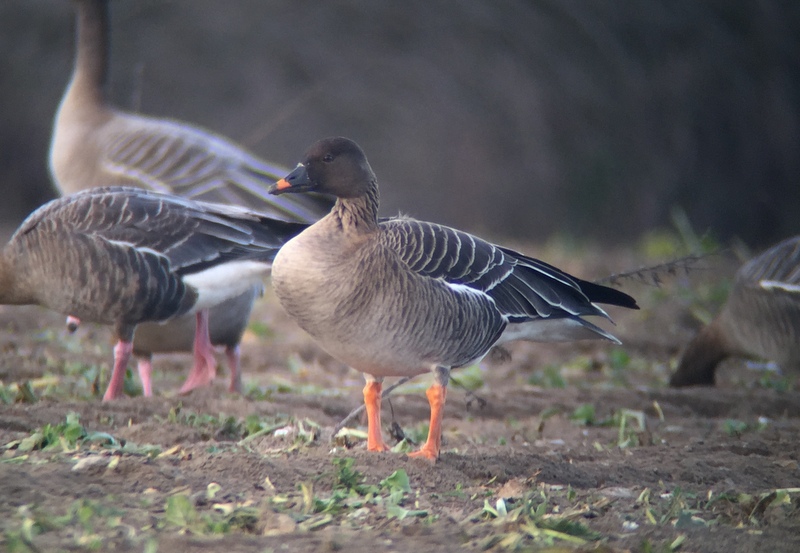 Tundra Bean Goose – with day-glo orange legs & bill band
Tundra Bean Goose – with day-glo orange legs & bill band
Pink-footed Goose is our commonest wintering species, with up to 100,000 coming here for the peak months of winter and the sugar beet harvest. Tundra Bean Goose is much rarer, as we are on the western edge of the wintering range for this species, which is more common in Netherlands and northern Germany. However, it has been a good winter for them this year and they are always great to see in with the flocks of Pinkfeet.
It was starting to get to owl time again, so we made our way back along the coast to Blakeney. It had brightened up nicely for a time, but typically it started to cloud over again and the wind picked up a bit. There is regularly an early Barn Owl out hunting here, but not today. It was a bit exposed out here today, so we decided to make our way back inland, to where it is more sheltered.
Our first circuit of the favoured hunting fields failed to produce any owls. It was starting to look worryingly like we might draw a blank today. We made our way back to one of the grassy fields and got out for a walk. Thankfully at that point our luck changed and a Barn Owl appeared. It did a quick circuit of the back of the field and landed low down in a willow. We just had time to get the scope on it before it was off again and disappeared back out of view. At least that was a start. A Tawny Owl hooted from the trees too.
Time was getting on, so we made our way up to the woods to look for Tawny Owls. There are some meadows next to the woods here which host a pair of Barn Owls. We had a quick scan here while we waited for the Tawny Owl action to start. It was already starting to get dark as one of the Barn Owls finally dropped out of its roost tree. They must be well fed this year, not coming out until so late! It flew round briefly and landed in another tree out of the breeze, where we could get it in the scope.
Then we made our way round to where one of the Tawny Owls likes to roost. We didn’t have to wait long until we heard the first hoot. He was not in the tree he had been using as a roost in recent weeks, but we got a bearing on where he was likely to appear. The next time he hooted, we could see him perched up in the back of the trees, silhouetted against the light. We got him in the scope, before he flew back along the line of trees.
A short while later, the Tawny Owl made his way back towards us through the trees. We couldn’t see him at first, but we could hear his hooting much closer to us. Then a large shape flew out over the trees in front of us on very broad rounded wings and across the path not far from us. It disappeared back into the trees again and seemed to go silent. We walked over in the direction it had disappeared and with a quick whistle, we got an instant response. It hooted a couple of times and then came flying back through the trees and over our heads. It landed again further back, silhouetted against the last of the light.
As it hooted again, another Tawny Owl responded. We walked back to the car surrounded by the hooting of Tawny Owls. Magical stuff!
















